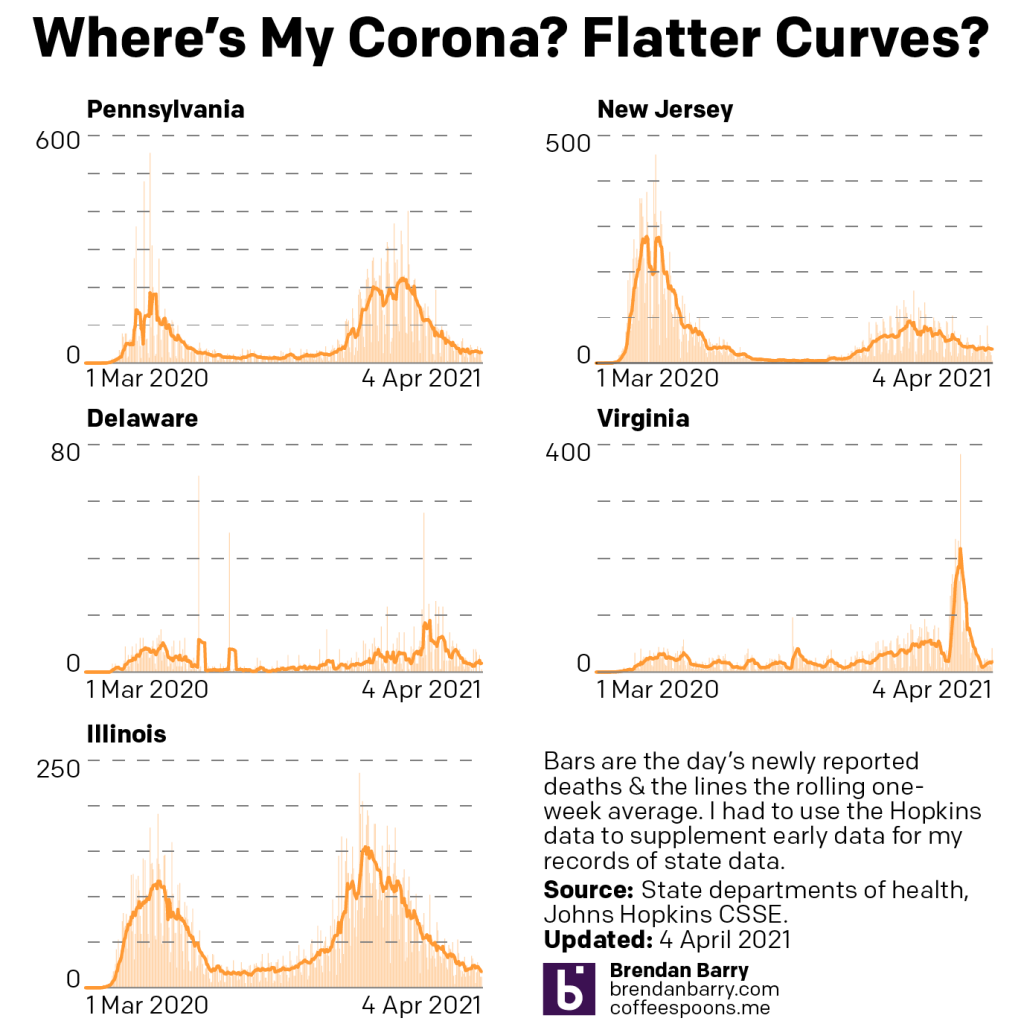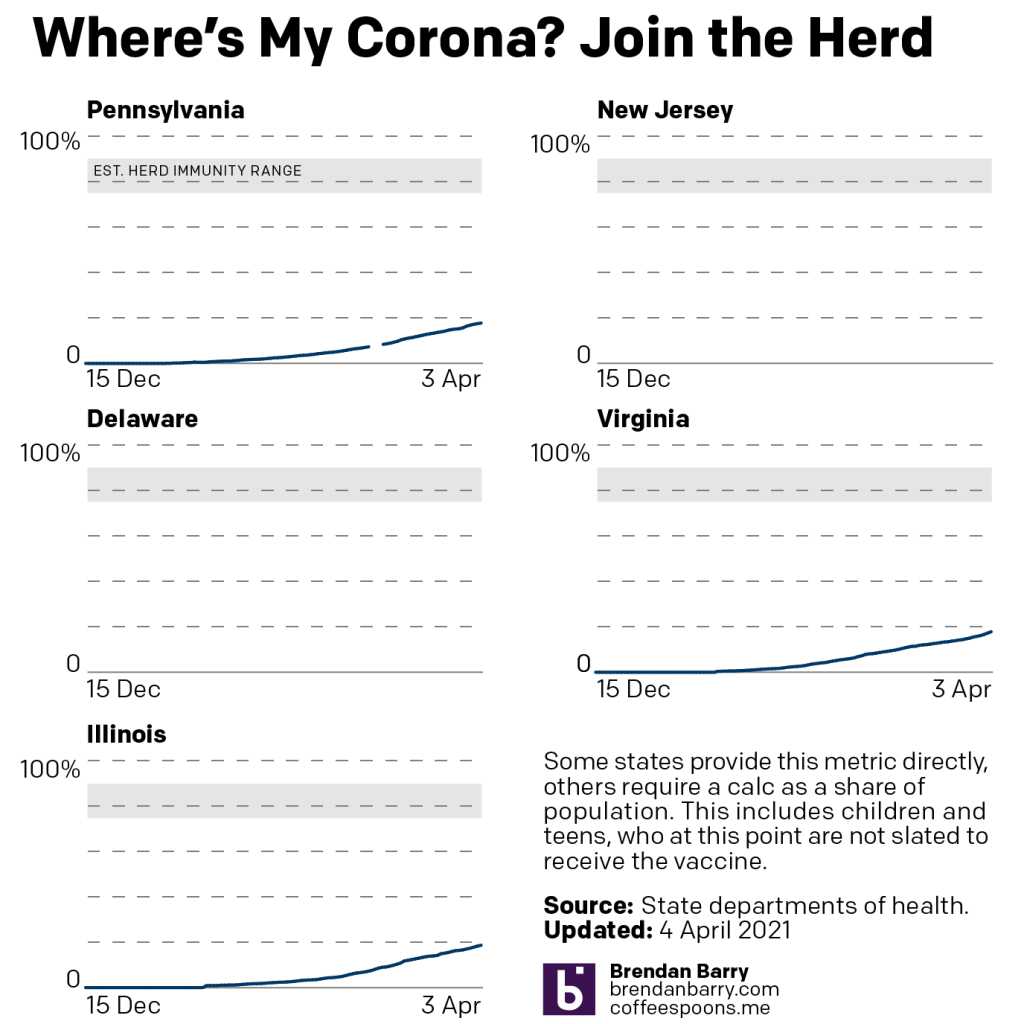Last week I wrote about how the inevitable rise in new Covid-19 cases was occurring in Pennsylvania, New Jersey, Delaware, Virginia, and Illinois. Now, one, in the last week, we saw no evidence of states preparing to reinforce their public health and safety restrictions. And two, whilst we have no data on people not following guidelines, anecdotally a large group of people threw a party in my building’s common amenities space so it does seem like people are feeling less inclined to wear masks, socially distance, and isolate to their own households.
Those two conditions, of course, do not help reduce the case count. Instead they add to it. So it should come as no surprise that Covid-19 continues to rapidly spread in our five states, though some are doing worse than others.

New Jersey and Pennsylvania arguably performed the worst. If we look at the peak to trough decline from early winter’s surge to late winter’s nadir, we can see that New Jersey has reached 40% of that peak. Pennsylvania enjoyed a better decline and so has a large gap, but is still nearing 20% its previous peak.
Illinois is also remarkable—again not in a good way—as its peak to trough fall was even greater than Pennsylvania’s, however it’s also now clearly rising. The Land of Lincoln, however, did manager to reach late summer levels of new cases—good. But those are now rising—bad. Delaware too is seeing a rise, albeit at a slower rate than its two tristate neighbours.
Only Virginia’s rise remains slight, barely discernible in the chart.
Deaths, while not exactly good news, aren’t exactly good news either. Last week I mentioned how they had stalled out and stopped declining. That is better than rising death rates, but the levels of deaths per day is still higher than we saw last summer. In other words, things could be significantly better even in pandemic terms.

Last week? Deaths continued to stubbornly persist at those elevated levels. We remain vigilant, looking for any indication that deaths will follow the rates of new cases and hospitalisations and begin to climb.
The hope, of course, is that we have vaccinated enough of the most at risk populations to prevent a surge in deaths. But, we just don’t know yet. The only good news is that vaccinations continue to progress.

Illinois has surpassed 18% of its population being fully vaccinated. Virginia is not far behind at 17.75%. Pennsylvania, because of the bifurcated nature of its data reporting, remains unclear. It sits at 17.8% fully vaccinated, but Philadelphia has not posted updated data since late Thursday. It’s likely that the Commonwealth has joined Illinois in surpassing 18%, but it’s not fully certain.
Also this past week, the CDC updated its guidance for the fully vaccinated, saying that it was safe for them to travel. I take some issue with this, primarily on the messaging front.
First, we need to be clear about what fully vaccinated means. It means two weeks after your final dose. For Johnson & Johnson’s vaccine, that means two weeks after your shot as you only receive one. For both Pfizer and Moderna, you are only fully vaccinated two weeks after your second shot—not before. And keep in mind with Pfizer you need to wait three weeks between first and second dose. With Moderna it’s four weeks. In other words, with J&J you need to wait two weeks after your first (and only) shot before you can begin to follow the loosened guidelines. If you receive Pfizer’s, you need to wait five weeks from your first shot, assuming you do receive your second three weeks later, and with Moderna it’s six weeks, again assuming the recommended four week gap.
The problem is that only about 20% of the US population is fully vaccinated. And with the virus spreading at high rates and at high levels, it poses a significant risk as the newer, more lethal, and more infectious variants could take root in the United States and overwhelm the healthcare systems of the 50 states. We do not yet know if fully vaccinated people can spread the virus if they do become infected.
I think the advice should have remained to refrain from all but essential travel until we reached a high percentage of fully vaccinated folks. I ballparked earlier this week something like 2/3 the estimated amount of full vaccinations required for herd immunity (est. at 75%). In other words, keeping restrictions on travel until at least 50% of the US becomes fully vaccinated.
We remain several weeks away from that milestone, unfortunately. I understand the desire/urge people have to get out and do things and enjoy spring after a year of isolation. Sadly, if winter was the darkest/hardest part of the pandemic, I think that makes spring and early summer the most challenging. Because we see progress, we see the light at the end of the tunnel, and it coincides with warmer weather and we want nothing more to get out and do things and see people. But that is the last thing we need to be doing at this point.
I’ve often described the vaccination as the marshmallow test. In a study, scientists presented kids with a marshmallow. They could eat the marshmallow immediately, but if they waited 15 minutes, unsupervised, they could then have an additional marshmallow. We are all just grabbing that first marshmallow whilst the promise of a more normal summer is ours if we can wait just 15 minutes.
Credit for the piece is mine.

One thought on “Covid Update: 4 April”